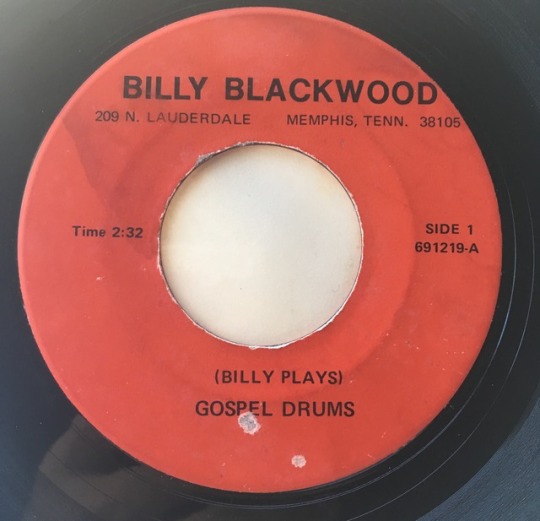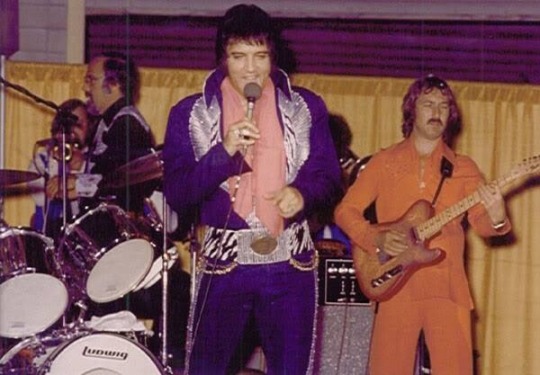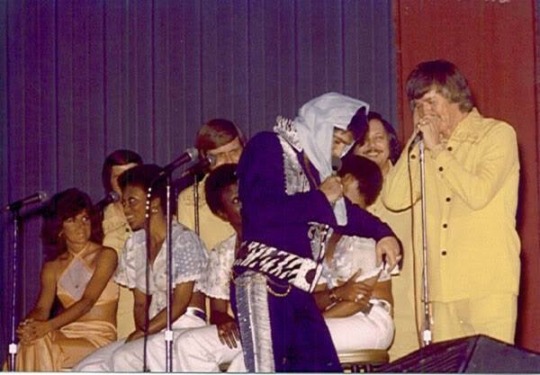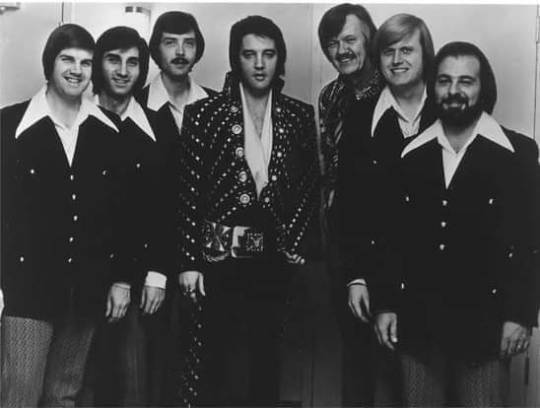#jd sumner and the stamps quartet
Text
ELVIS' RESPECT FOR GOD
On one occasion in Elvis' suite, J.D. and The Stamps were gathered around the piano, singing "Sweet, Sweet Spirit", while the other visitors were noisily chattering away. Elvis became irritated, jumped up on a stool, waved his arms and hollered at everyone, "Shut up, goddamnit! They're singing about Jesus!"
A hush fell over the room, and all you could hear was the sound of the lilting spiritual. "Y'all should be quiet," he whispered. "They're singing about Jesus … come on." Everyone was looking up sheepishly at Elvis, like he was Moses standing on Mt. Sinai. His choice of words struck me as incongruously hilarious, but I did realize that in his own way he was expressing his reverence for the Lord, and I admired him for this.
Excerpt from "Elvis and Kathy" (1987) by Kathy Westmoreland
youtube
#elvis presley#jd sumner and the stamps quartet#kathy westmoreland#elvis#elvis the king#elvis fans#elvis fandom#elvis history#70s elvis#elvis on tour#gospel music#elvis library#elvis books#Youtube
44 notes
·
View notes
Text
I’ll Remember You
Most people may not think of a concert as a rhetorical situation. But in order to have so many people feel the same way, and react in the same way exercises massive amounts of persuasion. Take, for example, Elvis Presley’s 1973 Aloha from Hawaii concert. This incredible event was broadcast live to the whole world, and more than 1 billion people watched. Unfortunately, we can’t experience the original concert, but recordings can still give us a sense of rhetorical strategies an event such as this brings.
The concert was a reminder, both then and now, that Elvis Presley was an incredible entertainer. Aloha from Hawaii is designed to highlight Elvis’s showmanship: from his American Eagle jumpsuit, to his ability to sing a myriad of genres, to his rapport with his audience and the appreciation he has for his band, the concert presents Elvis’ style of entertainment through the years. All of this loaded into an hour long concert that took place in Honolulu, Hawaii in 1973.
The concert begins in total darkness. The TCB band crescendos into Also Sprach Zarathustra. The crowd cheers in anticipation. Some of these people have waited years to see Elvis in concert, and they’re made to wait just a bit longer. Tension builds, the song crescendos to the climax, then we’re launched into the fast paced intro of C.C. Rider. And there he is. Elvis appears from backstage illuminated by a spotlight. He makes his way up and down the length of the stage, greeting his loyal fans. He successfully asserts himself as someone worth waiting for. Long-time friend Charlie Hodge hands Elvis his guitar, and Elvis springs into C.C. Rider. The entire concert goes from high energy, to slow and sweet, then back - keeping the audience entertained without tiring them out. We are bathed in the beauty of the gospel song You Gave Me a Mountain early on, Elvis giving us a glimpse of his roots as a southern Christian boy who sang at church every Sunday. This smooths out his “rough edge”, and helps him connect with more reserved audience members. Classics such as Blue Suede Shoes and Hound Dog throw us back to the early days of rock and roll, whose beats - along with Elvis’ “lewd” movements - were the stuff of controversy. It’s almost laughable when you compare it to the “things kids are doing these days”. Elvis’ incredible vocal range gives him access to a spectrum of genres, and he performs them all with charisma and passion.

The intense connection between Elvis and the TCB band also plays a role. There are several moments throughout this concert where Elvis “becomes a part of the audience”, and is lost in the magic that is the TCB band. They take up the entire length of the stage, the Joe Guercio Orchestra sits in the back, Glen Hardin is at the piano on the left, Charlie Hodge plays rhythm guitar, Ronnie Tutt on drums, James Burton on lead guitar, and Jerry Schiff on bass guitar. A massive band, with no director. We also have J.D. Sumner and the Stamps quartet, the Sweet Inspirations, and Kathy Westmoreland to sing backup. The quality of the music is awesome, to have this many parts moving in unison with no direction is hard to believe. So when Elvis turns his back to the audience, and just watches in awe, we know exactly how to feel.
In the 1970s, several performers wore jumpsuits on stage. But the only one people seem to remember, is Elvis Presley. And which jumpsuit is the one people wear for Halloween? The American Eagle. For good reason. It cost $65,000 to make in 1973, and to make the same suit today it would be 4 times that amount. Weighing about 75 pounds, it’s a wonder Elvis was able to move so well. The various eagles were created with semi-precious stones. The red and blue eagles on a white suit show how proud Elvis is to be American, and he’s not afraid for the rest of the world to know. A massive belt and matching cape completed the suit, but the cape was too heavy, and therefore only worn for the ending song Can’t Help Falling in Love, before it was tossed into the audience. The belt was also given to another lucky member of the audience a little earlier, just after An American Trilogy. These items were worth much, and Elvis gave them without hesitation. Presley was well known for his charity, and knew he could make a difference in people’s lives. The Aloha Concert raised $75,000, and all of this was given to the Kiu Lee Cancer Fund. Elvis blessed lives not only with his music, but with the riches that music brought.
Elvis was also known for wearing silk scarves during his performances, it was no different in Aloha from Hawaii. Charlie Hodge was the dedicated scarf-adorner, putting one around Elvis’ neck to keep the flow of the concert going. Sometimes scarves were worn for several songs, then flung into the crowd. Other times Elvis would get one after another, wiping the sweat from his brow with one, from his chest with another, always making it great fun for the screaming fans. Many times Elvis would bend down and grant kisses to the ladies who swarmed the sides of the stage. Elvis received many Hawaiian leis in return, and ended up having to take some off in order to accept more. Not only does Elvis give gifts to his audience, they return the favor. During Fever, the audience is teased by Elvis’ movements, which are timed exactly to accents in the song. Suspicious Minds gives us some low lunges, and humor with the line, “ I hope this suit don’t tear up, baby!” instead of the original lyrics. The screams from the audience show they are enjoying themselves. A great performer knows how to read an audience, and Elvis is a master.

The camera shots used to record this performance make us feel we are truly a part of the original audience, and sometimes even closer. A great example of this is during An American Trilogy. We start off with Elvis facing James Burton, the lead guitarist, and away from the audience. The camera hugs in close, only Elvis and Burton are seen. As Burton begins the opening line, the camera moves to focus on him, Presley’s back is to us. When Elvis begins singing, he moves back to the center of the stage. He passes off the second part to JD and the Stamps, and watches them intently, the microphone at his hip. He gives these incredible performers their moment in the spotlight, acknowledging he wouldn’t be able to do this without them. As the Stamps sing the second verse, the camera is once again behind Elvis, giving us his perception. The Sweet Inspirations, who sit in front of the Stamps, sway slowly to the music. When it’s Elvis’ turn to sing again, he finally turns to the audience, yet his eyes are closed. This moment feels personal, and Elvis is sharing his soul with us. The shot fades to a farther away position, we are now able to see the whole band with Elvis illuminated by spotlights. Though his eyes are still closed, there is power in his body language, and his iconic shaky leg matches the slow acceleration of the snare drum. Closing in on Presley again, he accentuates parts of the song with arm movement. It feels as though the music controls him, instead of the other way around. As the intensity builds in the song, Elvis finally opens his eyes, and looks directly into the camera, and we feel as if he were staring at us. He closes his eyes again as he begins the “All My Trials” section, his voice lulling the baby he sings about. During the line “You know you’re daddy’s bound to die.” his shoulder drops, it seems as if it’s a foreshadow to his death, only 4 years in the future. This entire section feels as if he’s praying, the close camera shots make us reverent, make us feel every word. As we move to the instrumental section, the intensity builds, and Elvis once again turns away from the audience, who is silent, giving us an even more intimate feeling. Singing the climax, Elvis faces the audience, the camera is behind the drummer, and we see that there is in fact an audience present, even though we felt it was just us privy to this passionate performance. Throughout the entire song, shots will fade to different instruments, but there is always a faded image of Elvis over top. Even when he’s not singing, you can’t take your eyes off him.
Aloha from Hawaii makes the argument that Elvis Presley was a great entertainer. He knew how to interact with his audience, even if they weren’t physically in the same room. The passion and charisma he holds makes every performance unique, and he shows us his soft side, along with the hunk side. Elvis’ entire story tells us how a great performer is made, and Aloha from Hawaii wraps up the decades long script, and shows us the whole package in an hour long concert. This makes Aloha from Hawaii an incredible thing to experience, even 40 years after Elvis’ death.
3 notes
·
View notes
Photo

Billy Blackwood “Gospel Drums” (Private Press, 1967?)
(Click title to listen or download)
Happy to be back with another 45 after a much too long and unanticipated break from the blog. To make up for it I’m dropping a favorite 45 on you all and hope to have a few more posts up in short time.
Today’s side is an absolute scorcher of interesting provenance. When one does and inventory of a “standard” Gospel tune and breaks it down into parts then ranks those parks the drums would probably not be in the top three. Often times a killer gospel 45 won’t even have percussion outside of some hand clapping. So when you drop this Billy Blackwood 45 on your turntable and side one reveals itself to be an unremarkable acoustic number the prospects for a riveting side of gospel drums is diminished even further.
Well, boy oh, boy does this record deliver!
Tons of open drums, awesome little organ lead in the middle of a drum solo, simple driving bass/guitar. A cold stop into a kinda flimsy and surfy guitar lead. They even kinda sneak a piano flourish. It’s a really really fun record that feels without inhibition and oozes youthful joy. AND IT’S FULL OF AWESOME DRUM BREAKS!
There’s no definite date I can pin on this 45 but it seems safe in terms of Billy’s bio and the sound of the record to put it at 1967 or 68. Billy Blackwood comes from the gospel royalty of the Blackwood Brothers gospel quartet at the time of this record, hailing from Memphis, TN. During the early sixties he sang with the Blackwood “Little” Brothers, leaving in 67 to drum with JD Sumner (who sang bass for the Blackwood Brothers until 1965) and The Stamps. It’s just speculation but feels right that this 45 sits in that pocket. He’s moved from early teenage singing to a touring drummer though he hasn’t left gospel music for secular sounds yet so even the instrumental break filled freakout is labelled “Gospel Drums.” In 1969 he joins his father in the Blackwood Brothers proper as a drummer which makes me think- again, along with the sound, instrumentation and general vibe- the record falls before 1969.
There’s also a mild connection here to Elvis Presley that is worth mentioning. Elvis was a big fan of the Blackwood Brothers and had auditioned for what was essentially their farm team The Songfellows. His inability to harmonize and later when he improved, his newly signed deal with Sun records got in the way of him joining that group. Elvis did have the Blackwoods back him up on recordings and their relationship continued including in 1973 when the group Voice with the Gospel Drummer himself Billy Blackwood on the kit. For those who are so inclined he seems to have at least one LP from the period between this 45 and the mid 70′s that features some of the ‘out’ tendencies of the period.
Billy’s foray into secular music didn’t last long and started his own mission in the early 80′s where he continues to practice- with music at the forefront- today.
I hope you enjoyed today’s record and always remember to flip the dang 45 over, you never know what the other side has in store!
Till the next rotation.
-George / Snack Attack
9 notes
·
View notes
Text
The Oak Ridge Boys' Richard Sterban-Episode 182
.@oakridgeboys bass singer @RASterban coming to @TheatreWestbury this Thurs 5/17! Sterban and I chat about going from Elvis to Elvira, including a crazy story about the King himself. Have a listen! #OakRidgeBoys
Today, Matt welcomes 1/4th of one of the most legendary vocal quartets in music history, Richard Sterban of The Oak Ridge Boys. The group will appear at the NYCB Theatre at Westbury on Long Island this Thursday, May 17th. Tickets are available at the theatre’s website by clicking here.
Richard Sterban’s career as a bass singer kicked off with a stint with the Stamps Quartet, spending about a year…
View On WordPress
#Country Musical#Duane Allen#Elvira#Elvis#Elvis Presley#JD Sumner#Joe Bonsall#Matt Bailey#New York City Axtell Expressions#NYCB Theatre at Westbury#Podcast#Richard Sterban#Talk For Two#The Oak Ridge Boys#The Stamps Quartet#The Tangent Bound Network#Vocal Groups#William Lee Golden
0 notes
Photo



8 June 1975 at 20:30 Jackson, Mississippi State Fair Coliseum 12,000 spectators Dress: Silver Phoenix Singers: Joe Guercio Orchestra, Kathy Westmoreland, The Sweet Inspirations, JD Sumner and The Stamps Quartet
1 note
·
View note
Text
Prayers For The Family Of Ed Hill
Prayers For The Family Of Ed Hill
Ed Hill has had a long and distinguished career as a Southern Gospel baritone singer. He was a founding member of the Prophets in 1959. He left them in 1965 (His replacement was Duane Allen of Oak Ridge Boys fame) but returned in 1966 and remained with them until they disbanded in 1973.
Ed next joined JD Sumner And The Stamps Quartet in 1974 and remained with them until 1979. In 1981, he…
View On WordPress
0 notes
Text
Elvis Presley’s Graceland to Host Holiday Concert Weekend December 14-15, 2018
Elvis Presley’s Graceland to Host Holiday Concert Weekend December 14-15, 2018
Three Concerts Celebrating Elvis Presley and the Christmas Season: Christmas with Elvis at Graceland with Live Orchestra led by Renown UK Conductor, Robin Smith; An Elvis Gospel Christmas Starring the Blackwood Brothers Quartet and Former Members of JD Sumner and the Stamps Quartet; and Elvis Live in Concert Featuring Legendary TCB Band Guitarist James Burton
In addition to special tours of…
View On WordPress
0 notes

